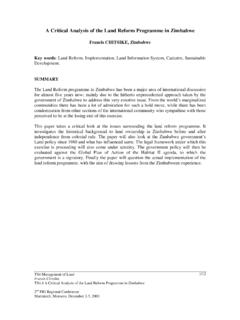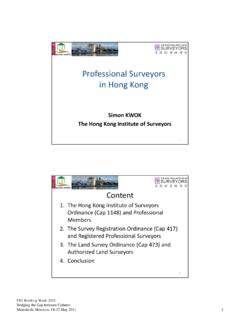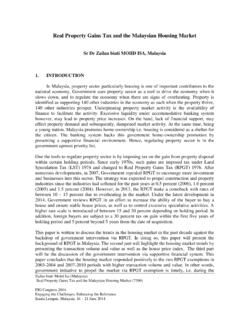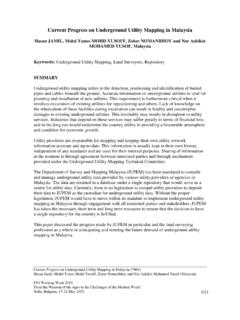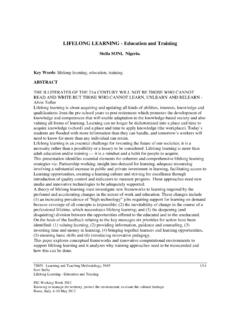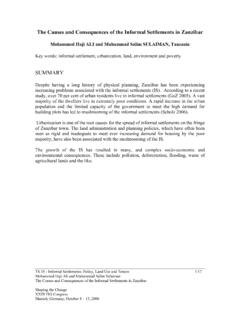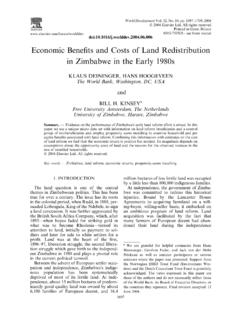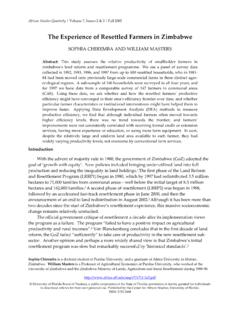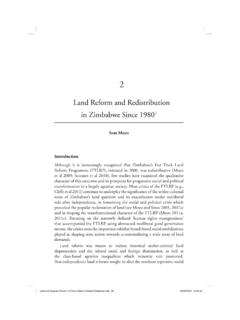Transcription of Land Tenure in Zimbabwe’s Post Agrarian Reform
1 TS 3A - land Tenure and land Administration Charles Paradzayi land Tenure in zimbabwe s post Agrarian Reform Strategic Integration of Surveying Services FIG Working Week 2007 Hong Kong SAR, China, 13-17 May 2007 1/6 land Tenure in zimbabwe s post Agrarian Reform Charles PARADZAYI, zimbabwe Key words: land Tenure , 99 year leasehold, Agrarian Reform , security of Tenure SUMMARY zimbabwe has embarked on a massive land redistribution programme which has resulted in thousands of hectares of land being unalienated by the state using the land Acquisition Act. The Act empowers the government to compulsorily acquire land for redistribution to the landless indigenous people. A massive cadastral surveying exercise is currently being undertaken to subdivide the acquired farms into smaller A2 models units.
2 The resultant diagrams and general plans of the subdivisions will be annexed to the 99 year lease documents. This paper attempts to analyze the 99 year leasehold Tenure system as it pertains to zimbabwe in the post Agrarian Reform programme. The paper will focus on the lease registration process, the surveying requirements and security of Tenure issues (mortgages, transferability, and collateral). TS 3A - land Tenure and land Administration Charles Paradzayi land Tenure in zimbabwe s post Agrarian Reform Strategic Integration of Surveying Services FIG Working Week 2007 Hong Kong SAR, China, 13-17 May 2007 2/6 land Tenure in zimbabwe s post Agrarian Reform Charles PARADZAYI, zimbabwe 1. BACKGROUND ON zimbabwe S land Tenure SYSTEM The zimbabwe land Tenure system dates back to the colonial era with the arrival of the colonial settlers in the late 1890s.
3 The settlers established a system that resulted in all land belonging to the Crown (the Queen of England) and stripped the indigenous people of their right to the land which they had possessed from time immemorial. The colonial regime divided the country into freehold land , state land , and tribal trust lands. The natives were forcibly driven from their ancestral homes and resettled in less productive land in the country. The First and Second Chimurenga were fought to redress this imbalance in the land distribution. At independence in 1980, it is estimated that 70% of all arable land was being held by a minority group of white commercial farmers (Chitsike, 2003). By 1994, only 400 out of 4400 large-scale commercial farmers were black (Neill, 2004).
4 Before independence, freehold land was the preserve of the white settlers while the few natives who had proved their mantle in farming were offered medium size freehold units in what were termed African Purchase Areas. The African Purchase Areas formed the buffer zones between the commercial farms and the Tribal Trust Lands. One school of thought is of the opinion that this arrangement was a deliberate move by the colonial masters to curb the spate of cattle rustling and other forms of sabotage by the peasantry on white-owned commercial farms. In 1980, zimbabwe inherited a land Tenure system which recognized both public and private ownership of land . The following forms of land Tenure are currently operational in zimbabwe : - Freehold Tenure Leasehold Tenure Commonhold (communal) Tenure Easement (servitude) Resettlement Permit hold Tenure State lands Unalienated land The land Apportionment Act of 1930 legally divided the land distribution according to race, thereby denying natives the right to own land in certain parts of the country.
5 This Act resulted in forced resettlement of natives from areas designated for large scale commercial farming or other state use such as game reserves and national parks and mining purposes into marginalized lands held under communal Tenure . TS 3A - land Tenure and land Administration Charles Paradzayi land Tenure in zimbabwe s post Agrarian Reform Strategic Integration of Surveying Services FIG Working Week 2007 Hong Kong SAR, China, 13-17 May 2007 3/62. Agrarian Reform In its quest to redress the land imbalances, which were in favour of the minority white commercial farmers, the zimbabwe government embarked on a Fast Track land Reform Program (FTLRP) from 2000. The FTLRP was in response to the spontaneous occupation of white-owned commercial farms by liberation war veterans and collaborators in the run-up to the 2000 Parliamentary elections.
6 The massive land redistribution programme has resulted in thousands of hectares of land being unalienated by the state using the land Acquisition Act. The Act empowers the government to compulsorily acquire land for redistribution to the landless indigenous people. The Department of Physical Planning is partitioning the acquired farms into either A1 or A2 model holdings using ortho-photography and other existing maps. The A1 model farms are based on the village concept, with communal residential and grazing areas, but separate farming areas. These are designed to alleviate pressure on the communal lands. A2 farms are much larger than the A1 farms and are self-contained and the owners are expected to engage in commercial agricultural operations.
7 It is estimated that there are 15000 A2 model holdings that require title surveys for annexure to the 99-year leases. The government of zimbabwe is now under pressure to grant secure Tenure to the new landowners so that they can use the land as collateral to develop infrastructure on the farms. The net effect of a secure Tenure is to unlock the investment potential of the holdings for sustainable agricultural production. The government has adopted 99-year leasehold as the type of land Tenure for the acquired A2 model farms. Under the Zimbabwean law, the 99-year leases have to be registered in the Deeds Registry and one of the requirements is that the land parcel in question should be surveyed in accordance with cadastral surveying standards and approved by the Department of the Surveyor-General (DSG).
8 The other forms of land Tenure are still recognized in the country. 3. 99 YEAR LEASEHOLD The 99 year lease is an agreement between the state, through the Ministry of Lands, land Reform and Resettlement (MLLRR) and the A2 farmer (lessee), that provides for the lessee to occupy and use a certain piece of land for an agreed rental for a period of 99 years (MLLRR, 2006). The 99-year lease agreement provides 99-years guarantee of land use if the farmer continues to meet the terms and conditions of the lease agreement. land use under leasehold is limited by the purpose of the lease and land legislation. Lease conditions for example may limit stocking limits, or land use options. The system imposes high levels of care on the leaseholder and any lease transfers may require State approval.
9 There are no rights to sub-divide or aggregate land . The state retains the power to acquire leases or withhold lease when the leasing period expires (Murombedzi and Gomera, 2004). Registration process The A2 farmers have to apply for the 99 year lease agreement from their respective Ministry of Lands offices at Districts, Provinces and Head Office. The Agricultural land Settlement Board will assess the application and make field visits to the farm of the applicant and submit their recommendations to the Minister of Lands, land Reform and Resettlement for determination. The outcome of the Ministerial determination is determined by the level of TS 3A - land Tenure and land Administration Charles Paradzayi land Tenure in zimbabwe s post Agrarian Reform Strategic Integration of Surveying Services FIG Working Week 2007 Hong Kong SAR, China, 13-17 May 2007 4/6agricultural productivity on the farms as well as the farmer s investment into infrastructural development.
10 The 99-year agreement is a long lease which has to be attested by a Notary Public according to the Deeds Registries Act before registration with Deeds Office as a Notarial Deed. The applicant has to pay stamp duty determined by the Registrar of Deeds at the time of application for the registration of the 99-year lease agreement. The lease agreement is normally registered in quadruplicate (two copies for the lessor, one for the lessee and one copy to remain in the Deeds Office). The agreement contains a property clause which refers to a survey diagram approved by the Surveyor-General. The diagram is meant to unambiguously describe the land under lease. Surveying requirements The land Survey Act (Chapter 20:12) and its allied Regulations provide for the demarcation of boundaries for any property subject to a long lease of 10 years or more.
